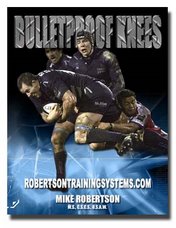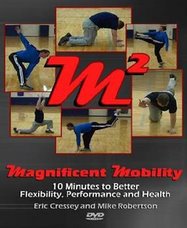High Octane Corrective Exercise and Performance Enhancement | www.RobertsonTrainingSystems.com
Thursday, October 11, 2007
Shift the Weight to your Heels
Give it a shot!
Mike Robertson
Tuesday, October 9, 2007
Spice Up Dumbbells with Isometric Holds
From the starting position of a dumbbell military or bench, hold the right arm extended as you take the left arm through the movement. Repeat on the opposite side by keeping the left arm extended and taking the right arm through the ROM. You can alternate arms, or if one side is significantly stronger than the other perform all the reps on the weak side before moving to the strong side. Not only will you prioritize your weak arm, you’ll pre-fatigue your stronger arm with the isometric hold.
Mike Robertson
Experience The Event That Took 30 Trainers, Coaches, and Athletes to the Next Level.
More on marketing...
Hey Mike,
I know you’re a busy guy so I won’t take up much of your time. As a business owner myself I study marketing and found the process by which I decided to purchase Bulletproof Knees interesting.
Basically, I’ve read much of your material on T-Nation and think that you’re knowledge and the ability to convey it is excellent so you didn’t have to sell me on that. However, justifying the expense for the book (especially since I’ll probably get hit with duty costs at the border) when there are so many alternatives out there was difficult to me. It’s not that it’s particularly expensive. It was more of a decision of which book to buy.
Here’s where it was strange. I’ve always thought that buyers decided that something was either worth the money or it wasn’t and that was that. Instead, I kept poking back in every so often to see the Bulletproof Knees site and reading over the same material. Eventually (today) it sold me and I made the purchase. I found that particularly interesting.
My guess is that there are several other readers on your mailing list in the same boat and frequent reminders and incentives to purchase the manual just might push them over the edge. Giving them a taste of what’s inside (maybe part of a sample chapter) might be enough to close the deal for some folks. I know it would’ve probably would’ve sold me earlier.
Anyway…you may or may not find this useful. I just thought I’d share.
Take care,
M
"The only way you’ll get them to cross the line is to do MORE marketing…or give different incentives."
Very interesting stuff indeed.
Stay strong
MR
Friday, October 5, 2007
Lift Strong Friday #12 – Craig Ballantyne
This week’s edition of Lift Strong Friday comes to us courtesy of Craig Ballantyne and his article, “Fat Loss for Busy Men and Women.”
Since meeting Craig last year at the Ryan Lee Boot Camp, I’ve come to really respect his no-frills approach to training and nutrition. This article gives you a quick summary of how to produce maximum fat loss in a minimal amount of time.
To learn more about Craig check out Turbulence Training site.
That’s it for this week. Have a great weekend and be sure to pick up a copy of the Lift Strong CD-Rom today!
Stay strong
MR
Thursday, October 4, 2007
N=1
What am I talking about exactly? I’m talking about trainees and coaches whose experience and frame of reference is limited to one person. Whether that one person is them, one client, etc. is irrelevant.
You’ll quite often hear people say, “I did X with Y client and it worked great.” Or, “I do A and got B.” The inherent problem is this – would you get that same result with another person? With multiple people? With an entire training group?
What I’m getting at here is using the “I do this because so and so says so” pisses me off. Could that person be correct? Sure. For example, I’d accept just about anything that Stuart McGill has to say about low back care, simply because he has a huge frame of reference. He’s worked with an infinite amount of people, and thus has a huge frame of reference.
Contrast this with Johnny Trainer or Internet Warrior, who used a 6-day split routine (with two arm days) to add an inch to his guns. His N=1; it worked for him, but it may not work for everyone else. His frame of reference is quite small.
Whenever you try to take in and assimilate new information, you need to think about the author’s level of credibility, his experience, and the number of people he’s trained to draw his conclusions from. Critical thinking is imperative if you really want to understand any topic.
N=1 doesn’t cut it any more. The key is consistent results with a large number of patients, clients or athletes.
Mike Robertson
Wednesday, October 3, 2007
Athletes and Motivation
In my ~9 years in the field, I’ve had the pleasure of working with a wide variety of athletes – weekend warriors and high school kids, all the way up to professional level ball players. One of the most interesting aspects of this is looking at how motivation levels differ between groups.
High school kids will, generally, have the lowest level of motivation. Quite often kids aren’t even cut anymore, and many are content just to “be on the team.” Collegiate level athletes will generally have more motivation across the board than high school kids, but less than a professional.
Now, keep in mind this is still an individual thing – you’ll always have your extremely high or extremely low motivation athletes on any given team, but as a general rule of thumb this works.
Motivation level then plays into how you must coach any given team or group. With lower motivation athletes, you’re going to need to do a little bit more “prodding” to get them going and performing at the level you’d like. These will generally be the kids that you need to work the hardest with, and there may be a certain level of hand-holding until they start to see progress and/or change.
In contrast, high level athletes inherently understand that doing weight training, plyos and agility drills will improve their performance. These are the athletes with whom you can take a more “hands-off” approach, and will respond well to tweaking and minor coaching adjustments. They’ll be the best at helping you regulate a large group of athletes, and may even pick up and employ some of the coaching tactics you use! Anyone who has ever had a high-motivation kid who’s also the best athlete on the team knows what I’m talking about here.
Quite simply, you can’t treat all levels of athletes the same. Determine their level of motivation and adjust your coaching style as necessary.
Mike Roberston
Tuesday, October 2, 2007
Planned Recovery is Key
And I'm not just talking day to day recovery. I'm talking about going with balls-out intensity day after day, and week after week until they either get injured or burn out.
For beginners, you can probably get by with an unload week every 6-8 weeks of training. Could you go longer? Maybe. But why bother? You might as well get in the habit of taking planned recovery weeks now.
For the more advanced trainees, I'd recommend an unload week every 3-4 weeks at the latest. When under high levels of stress outside of the gym, some of my best progress occurs when I alternate loading and unloading weeks on a 1:1 ratio!
Regardless of what you decide on, planned recovery is one of the simplest things you can do to keep yourself healthy and seeing progress.
Who ever would've thought I'd have to ask you to take some time off? ;)
Mike Robertson








